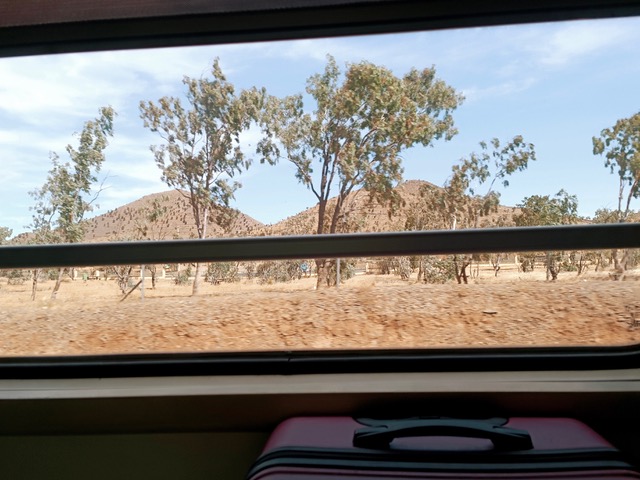
Dusty landscape. Photo © Karethe Linaae
Did you know Morocco was the first country to build a high-speed railway system on the African continent? After the railway line opened in 2018, one can now take a train from Tangier in the north to Casablanca on the Atlantic coast in a couple of hours, something that lasted almost five hours in the past. Not that one should rush when one travels by train, as there is no better way to see the world.
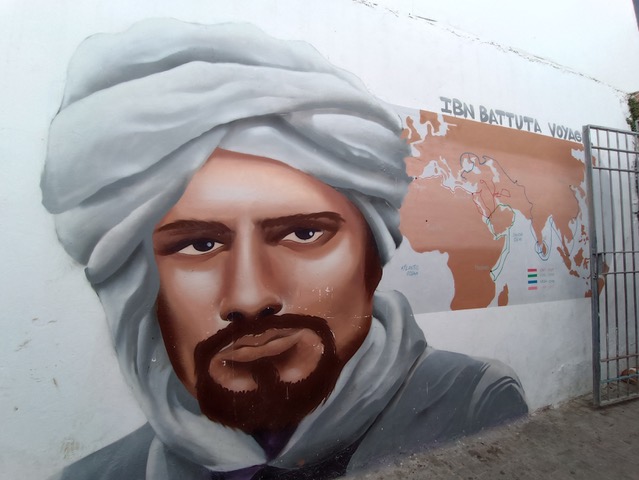
Street art, Tangier. Photo © Karethe Linaae
Morocco is a perfect travel destination for those who live in Spain. If one wants to experience something unique, it’s a different world. To my husband and me, trains are a great way to visit any country, so we head across the Strait of Gibraltar to check out the Moroccan national railway system, ONCF (Office National de Chemins de Fer).
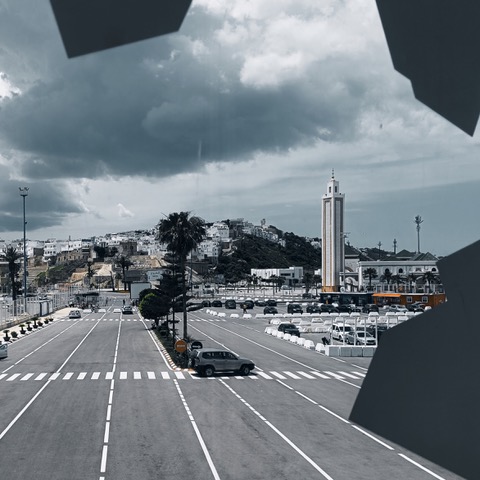
Arriving in Tangier by ferry. Photo © Karethe Linaae
After a brief hour on a hydrofoil from the Andalusian surf town of Tarifa, we arrive in Tangier – now Morocco’s fourth largest city with just short of a million inhabitants. From here, there are high-speed trains to the capital, Rabat and on to Casablanca (which in global context still is best known due to the 1942 film by the same name). From this express line, conventional slower trains branch off to the inland cities of Fez, Meknes and Marrakech, the latter, our southernmost point on this journey.
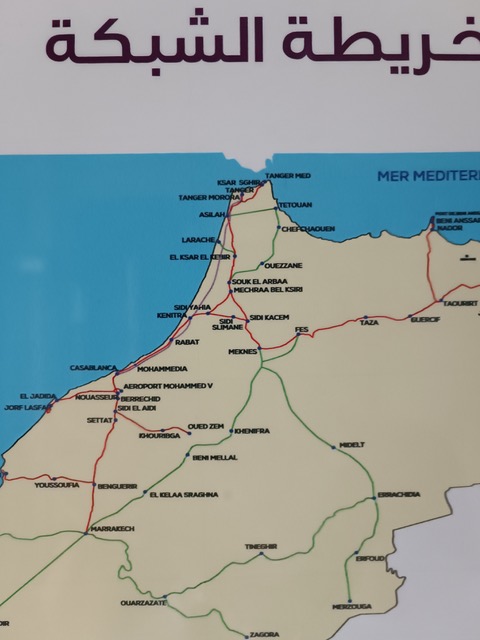
Map with train lines. Express line in purple. Photo © Karethe Linaae
The Express from Tangier to Rabat
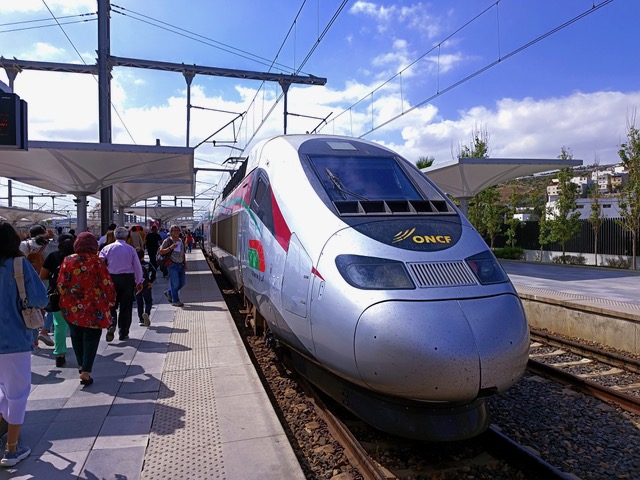
Africa’s first and fastest high-speed train, Al Boraq. Photo © Karethe Linaae
Trains from Tangier leave from the airy, modern Tanger Ville station, which features shops, cafes, a garden, and separate waiting lounges for first and second-class passengers. The station and platforms are much cleaner than in most Spanish towns and this seems to be the case at all the other stations we visit.

The beautiful train station Rabat Ville. Photo © Karethe Linaae
Only 323 km of Morocco’s 4225 km of railway lines are configured for high-speed trains, but the plan is to expand these to connect the rest of the country. Recently ONCF issued a tender to expand its high-speed train to Marrakesh, though we won’t be able to enjoy this ride until at least 2027. What’s the rush ...
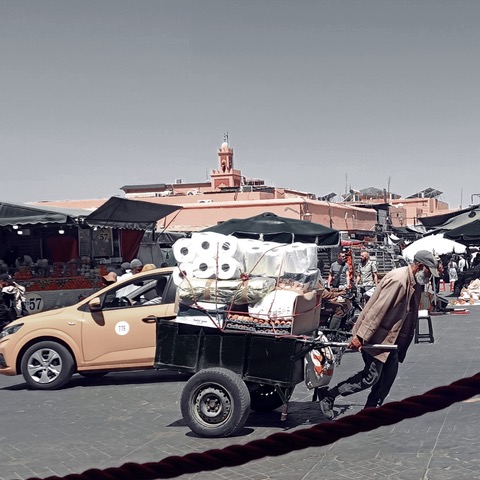
Morocco. Photo © Karethe Linaae
The Al Boraq trains are Morocco’s first high-speed railway and Africa’s fastest (max speed 320 km/h). The futuristic locomotives may resemble the French TGV trains because they are built by the same company and have similar comforts. It is wise to pre-order tickets online, as these trains, which are fast, clean, comfortable as well as punctual and reasonable compared to Europe, sell out easily. The only drawback that should be mentioned is that they do not have WIFI onboard, but at least there are plugs to charge mobile phones by the seats.
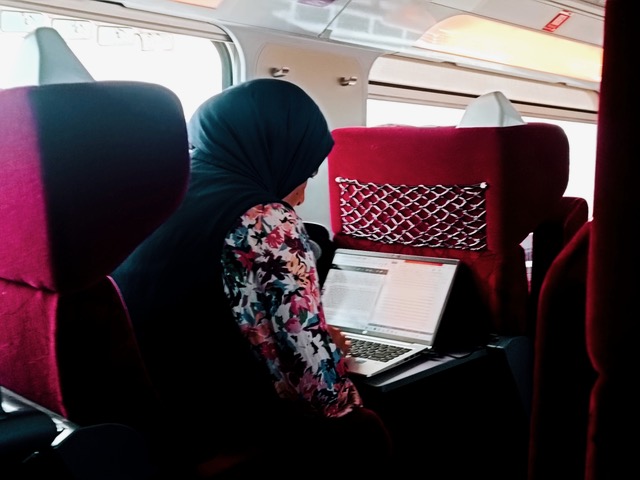
It is not only me who has to work on the train … Photo © Karethe Linaae
After a night in Tangier, our initial ride is with a two-storey high-speed train from Tangier to Rabat. The first-class ticket costs about 30 euros one way, which is quite reasonable for a 235-km journey in ultimate comfort. There are departures every hour, and we chose to leave at 11.00 allowing time for a café au lait and a walk around town before we board.
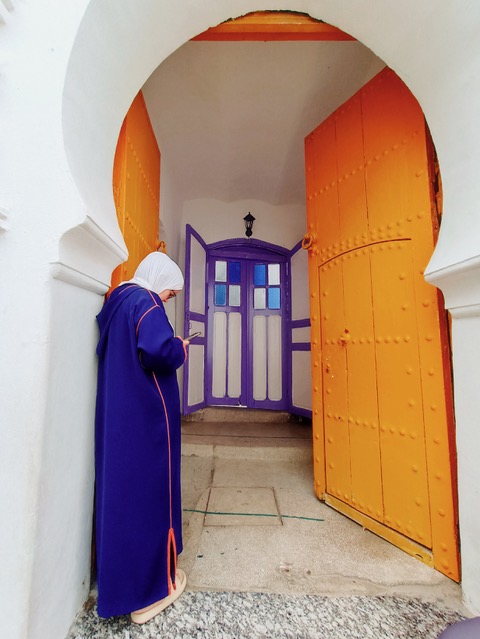
Doorway. Photo © Karethe Linaae
One can also take a night train with a couchette where one departs Tangier at night and arrives in Marrakesh the next morning. We prefer to travel in the daytime but assume that the quality and services are equally good at night.
By mistake, we seat ourselves in a second-class car which seems quite all right, but the ticket inspector immediately refers us to the first-class carriage a little further ahead. This has two rows of ultra-wide comfortable velvet-covered seats that resemble a small sofa. The trains also have a cafeteria car, although the selection is not exactly a gastronomic experience. The seats feature large, extendable tables with plenty of space for a laptop, but I must admit that I mostly end up sitting and staring at the lush landscape as we speed south.
We arrive at Rabat’s Casa Voyageurs station one hour and 20 minutes later and have just over fifteen minutes to change trains. This proposes no problem as it happens to be on the same platform. From here, the journey continues by conventional train to Marrakech.
Traditional train – Rabat to Marrakech
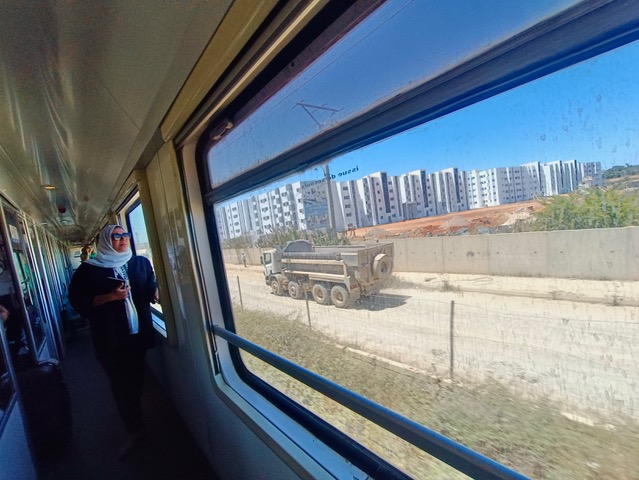
Rabat-Marrakech. Photo © Karethe Linaae
The slower Al Atlas trains are the most popular means of transportation for the locals, so this part of the journey is a lively and social experience. Therefore, advance purchasing of tickets is also vital. The distance between Rabat and Marrakech is 334 km, and the journey lasts at least 3,5 hours. This segment also costs about 30 euros one way in first class, and even if the tickets are double the price of second class, it is well worth the extra dirhams.
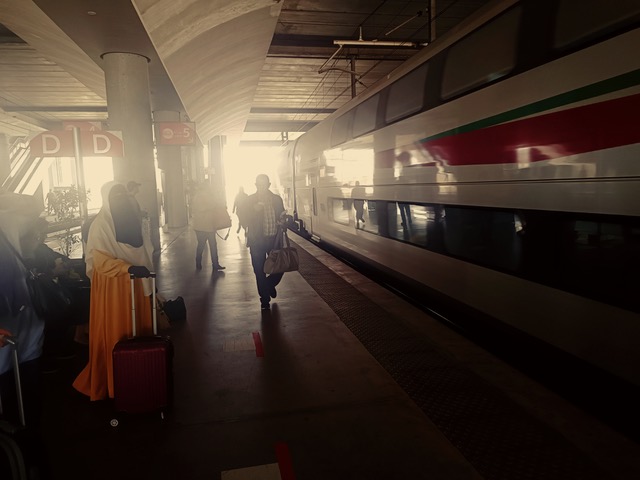
Rabat station. Photo © Karethe Linaae
There is a crush of people on the platform, but this time we find the right compartment on our first try. The Al Atlas trains have a corridor on one side and are divided into smaller, classic train compartments on the other, something we have not experienced since travelling in India. The first-class compartments have seats covered in worn velvet with space for six passengers. Otherwise, there is only space for luggage on the shelf above the seats, so the passengers end up leaving their luggage in the narrow corridors. Eventually, the poor man with the snack trolly can barely squeeze past the huge Japanese-sized suitcases.

Snack cart. Photo © Karethe Linaae
From what I detect the second class has plastic-covered seats, more people in the same compartment and corridors filled with people. At least we are lucky that our WC has toilet paper, a seat, and a small wash basin (even if the door won’t close and potential fare dodgers use it as their smoking lounge…) From what I have read, the loo in the second-class cars still has the classic hole in the floor, but even with this article in mind, I have no further desire to confirm this.
As soon as we sit down, a couple of American travellers enter and insist that we sit in their seats (again something we only have experienced on Indian trains). Upon further investigation, it turns out that their tickets were for the day prior. This leads to a lively debate, especially when someone in our compartment informs them that the fine for an invalid ticket is 120 euros - per person. The couple decide against hiding in the toilet (like it happens in the movies) and depart at the first station to buy new tickets before receiving a hefty fine.
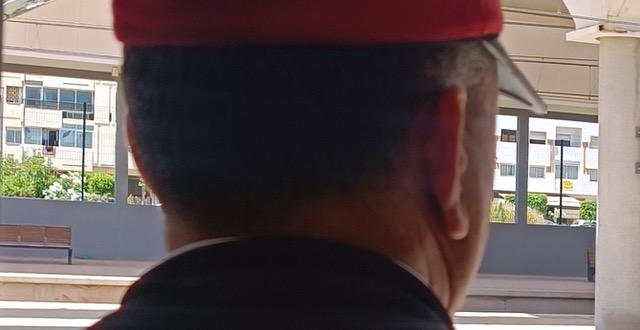
Ticket controller. Photo © Karethe Linaae
We have barely sat a couple of minutes when a gentleman comes in and gesticulates in a mixture of Arabic and French that my seat belongs to him. This time he is completely right. I explain that the reason why I am sitting in his seat is because the lady across from me is sitting in mine. The friendly man agrees to find a free seat in another compartment, and all is peaceful until the ticket controller comes and thus continues the eternal Game of Thrones.
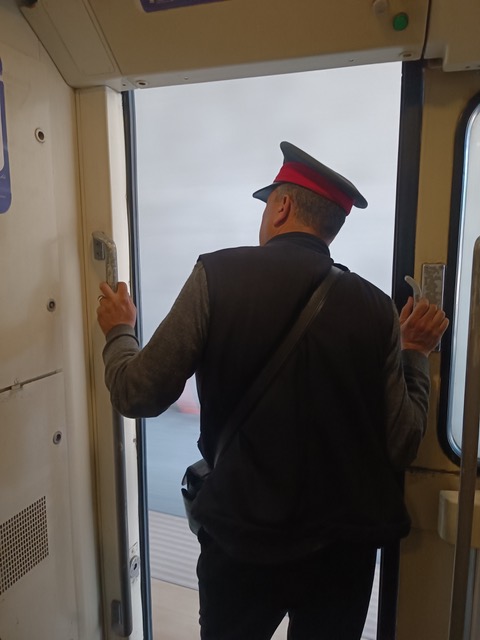
Ticket controller, Al Atlas. Photo © Karethe Linaae
We do not have a worktable in front of us on this train. However, there is ample entertainment with the virtual United Nations sharing the compartment with us. Our travel mates are from Morocco, France, Romania, and Australia, while we represent Mexico and Norway.

Our travel mates. Photo © Karethe Linaae
Whereas the countryside between Tangier and Rabat is green, hilly, and agricultural, the journey inland is more desert-like. Between a handful of stops in some smaller towns, we pass a sand-coloured landscape with an occasional bush, houses and huts in pink, orange and camel-colour, a dusty herd of goats and most of all, sand.
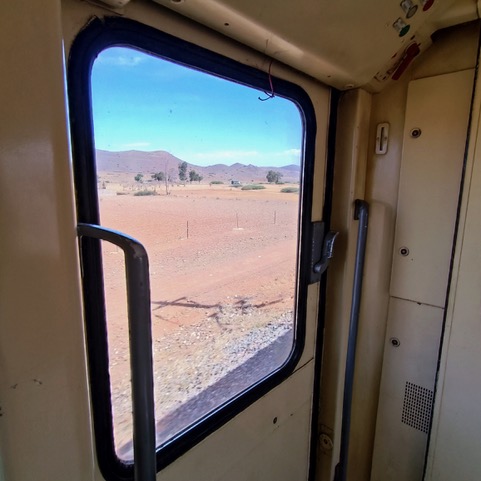
Al Atlas train to Marrakech. Photo © Karethe Linaae
When we approach Marrakesh, the terrain starts to undulate a bit more. The Atlas Mountains tempt further explorations. Perhaps next time ... The trip from Tangier to Marrakesh took just over five hours, but the time flew by, far too quickly given that the entire journey was like a geographical and cultural study.
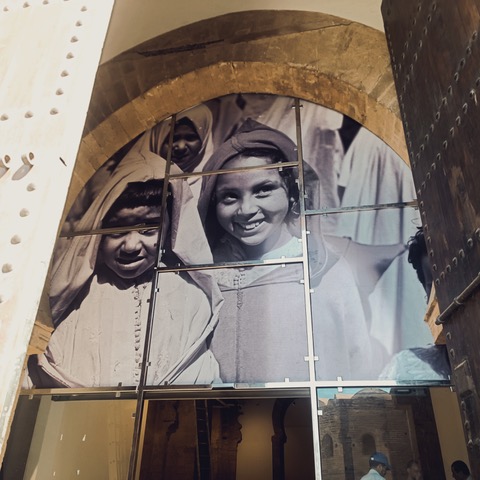
Changing society. Photo © Karethe Linaae
At the station, Muhammed (with a sign with our names printed on it) awaits to chauffeur us to our Riad – the typical Moroccan guesthouses that now often operate as boutique hotels, often with only a handful of rooms. We have a few days here and a couple in Rabat before we take the same train ride in reverse to Tangier and the ferry back to Spain. But we will certainly be back for other adventures.
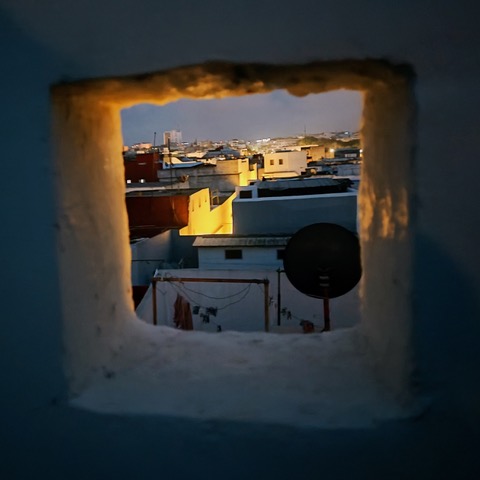
Peek view. Photo © Karethe Linaae
While the lively traditional trains are an experience I wouldn’t be without, the high-speed trains of Morocco can compete with the express trains of any European country. The best thing about this type of travel is that one doesn’t need to sit cramped into an aeroplane seat, worry about getting lost while driving, or find free parking in yet another unfamiliar city.
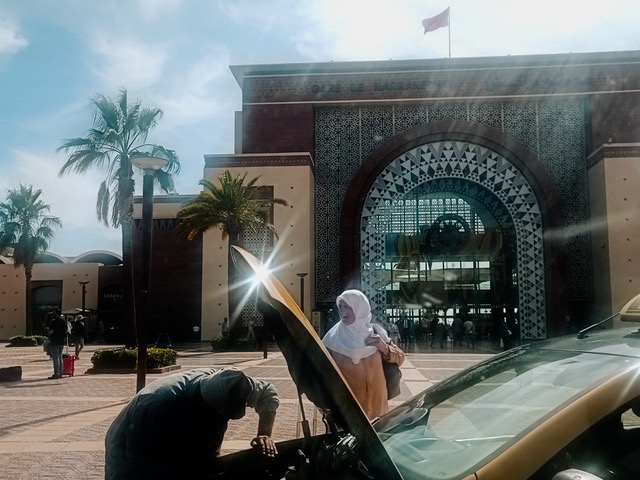
Motor stop, Marrakech. Photo © Karethe Linaae
At the same time, one can feel good about choosing the most sustainable public transport method available.
Happy trails!
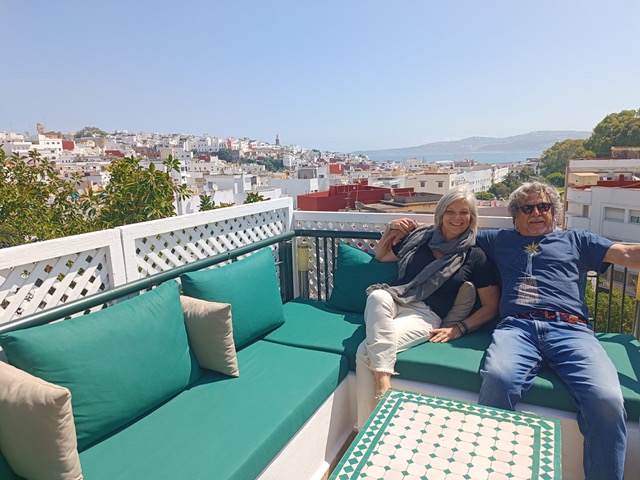
Roof terrace, Tangier. Photo © Karethe Linaae